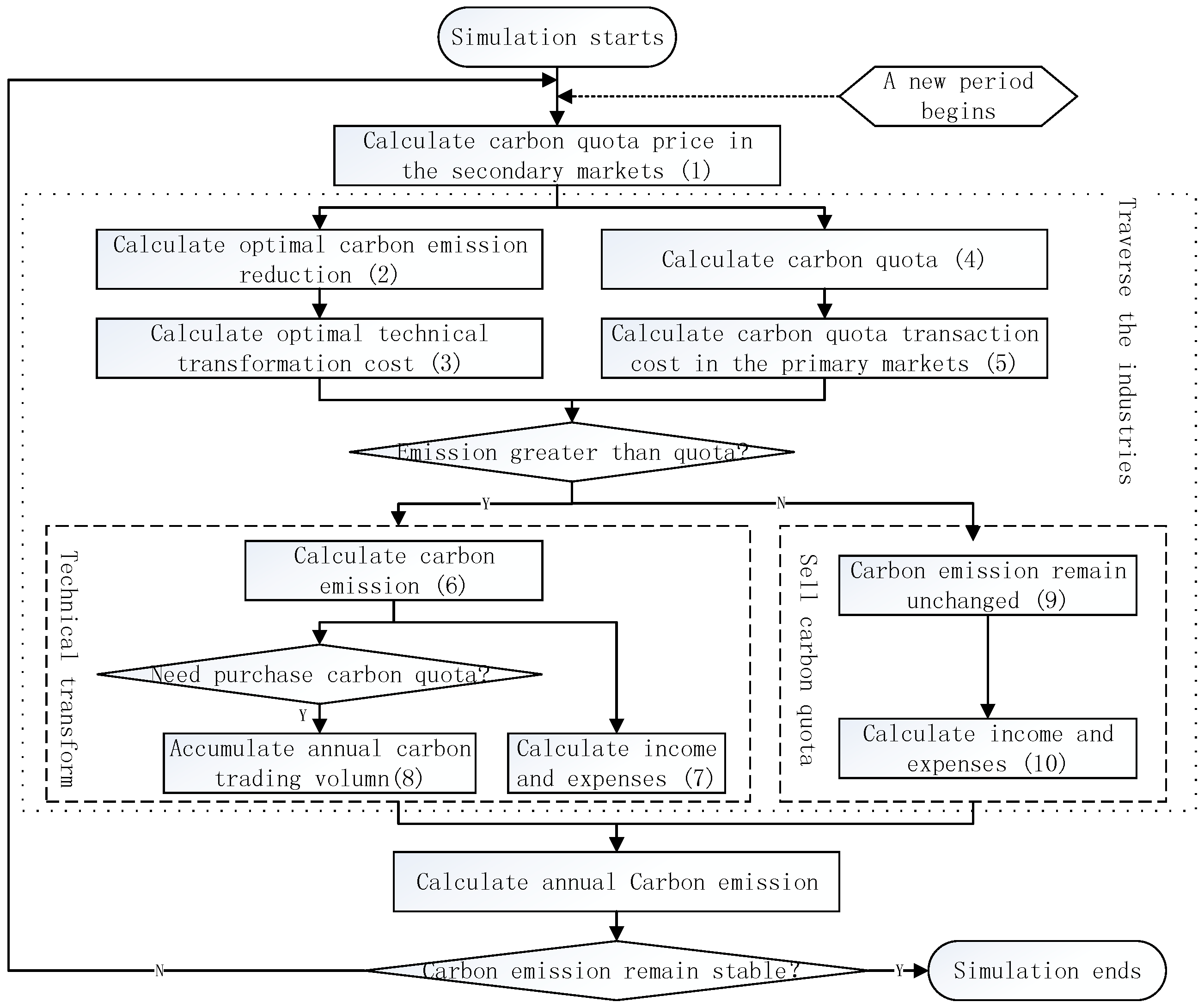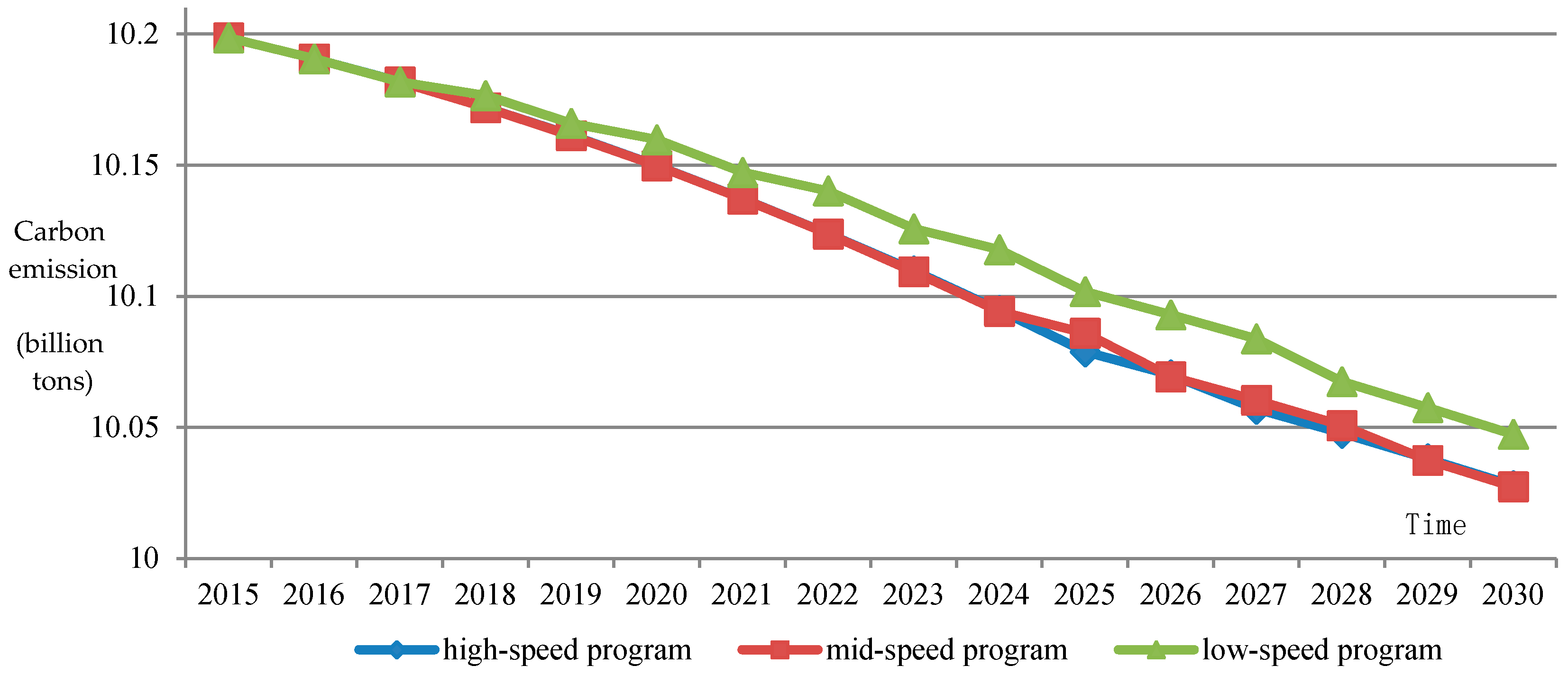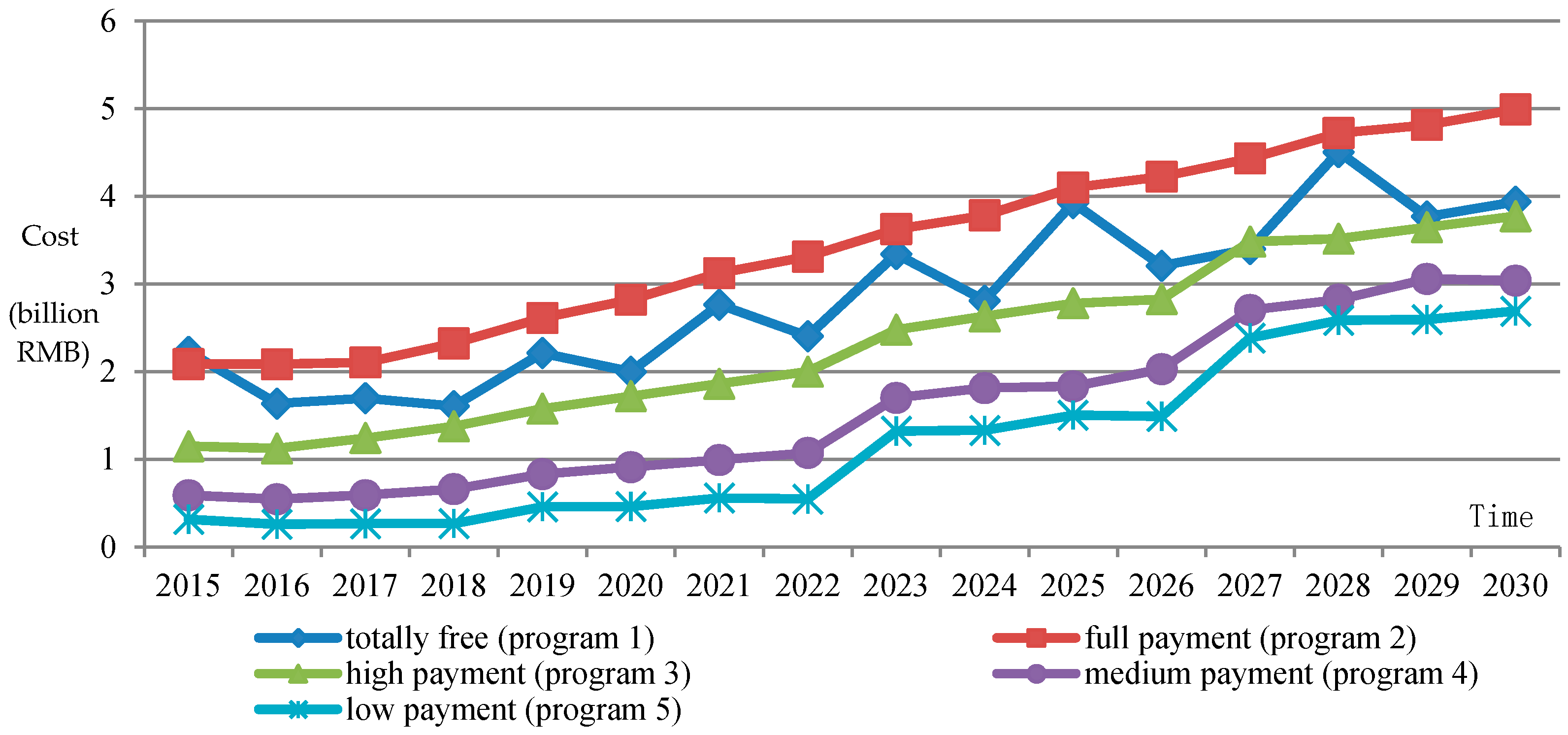Impact of Carbon Quota Allocation Mechanism on Emissions Trading: An Agent-Based Simulation
Abstract
:1. Introduction
2. Establishment of Agent-Based Carbon Emission Trading Simulation System
2.1. Selection of Agents
2.2. Design of Carbon Emission Trading Mechanism
2.2.1. Carbon Quota Allocation Rule
2.2.2. Transaction Rule
3. Simulation of Carbon Transaction among Industries
3.1. Simulation Environments and Basic Assumptions
- (1)
- The carbon quota transaction market is a perfectly competitive market. Therefore, the transaction prices of different emitters are the same in one transaction period. Consequently, the trading object chosen by the emitters should be random.
- (2)
- There are only two choices for an emitter in one transaction period. Specifically, an emitter either makes a technical transformation to reduce carbon emissions or purchases carbon quota to achieve the emissions target.
- (3)
- The carbon quota requirement of all the emitters can be satisfied. In other words, the overall supply of carbon quota is sufficient.
3.2. Data Sources
3.3. Simulation Results and Analysis
4. Conclusions and Prospects
- (1)
- In the assumption of the perfectly competitive market and zero transaction costs, the carbon quota transaction policy mechanism can significantly bring about carbon emissions reduction. Specifically, although the carbon quota allocation and transaction mechanism varies, the carbon emission decreases in the context of the total carbon emissions control. This means that the carbon quota transaction policy contributes to the carbon emissions reduction significantly.
- (2)
- Based on the comparison of different carbon quota allocation mechanisms, we conclude that the mechanisms are capable of promoting the carbon emissions reduction. Specifically, by considering both the carbon emissions reduction and its cost we obtain the result that the slow carbon quota reduction approach in the mixed allocation mechanism has the minimum cost of unit carbon emission. In other words, it realizes the minimal economic impact of the carbon emissions reduction on the premise that the carbon emissions achieve the target. On the other hand, the variation of the carbon quota has an interval threshold, which means that excessive quota decrease cannot promote the emitters to reduce emissions. For example, taking into account the requirement for both the carbon emissions reduction and economy development, it is of necessity for China to implement the mixed carbon quota allocation mechanism and ensure that the proportion of initial free quota is higher than the proportion which should be purchased by the emitters.
Acknowledgments
Author Contributions
Conflicts of Interest
References
- Kyoto Protocol. Available online: http://unfccc.int/kyoto_protocol/items/2830.php (accessed on 10 August 2016).
- Mathys, N.A.; de Melo, J. Political Economy Aspects of Climate Change Mitigation Efforts. World Econ. 2011, 34, 1938–1954. [Google Scholar] [CrossRef]
- Verma, Y.P.; Kumar, A. Potential impacts of emission concerned policies on power system operation with renewable energy sources. Int. J. Electr. Power Energy Syst. 2013, 44, 520–529. [Google Scholar] [CrossRef]
- Nelson, H.T. Planning implications from the interactions between renewable energy programs and carbon regulation. J. Environ. Plan. Manag. 2008, 51, 581–596. [Google Scholar] [CrossRef]
- Ishikawa, J.; Kiyono, K. Greenhouse-gas emission controls in an open economy. Int. Econ. Rev. 2006, 47, 431–450. [Google Scholar] [CrossRef]
- Greaker, M.; Pade, L.L. Optimal carbon dioxide abatement and technological change: Should emission taxes start high in order to spur R&D? Clim. Chang. 2009, 96, 335–355. [Google Scholar]
- Green, R.; Yatchew, A. Support Schemes for Renewable Energy: An Economic Analysis. Econ. Energy Environ. Policy 2012, 1, 83–98. [Google Scholar] [CrossRef]
- Pang, R.Z.; Deng, Z.Q.; Chiu, Y.H. Pareto improvement through a reallocation of carbon emission quotas. Renew. Sustain. Energy Rev. 2015, 50, 419–430. [Google Scholar] [CrossRef]
- Zhang, Y.J.; Wang, A.D.; Da, Y.B. Regional allocation of carbon emission quotas in China: Evidence from the Shapley value method. Energy Policy 2014, 74, 454–464. [Google Scholar] [CrossRef]
- Silva, E.C.D.; Zhu, X. Global trading of carbon dioxide permits with noncompliant polluters. Int. Tax Public Financ. 2008, 15, 430–459. [Google Scholar] [CrossRef]
- Shaw, K.; Shankar, R.; Yadav, S.S.; Thakur, L.S. Supplier selection using fuzzy AHP and fuzzy multi-objective linear programming for developing low carbon supply chain. Expert Syst. Appl. 2012, 39, 8182–8192. [Google Scholar] [CrossRef]
- Zhang, B.; Xu, L. Multi-item production planning with carbon cap and trade mechanism. Int. J. Product. Econ. 2013, 114, 118–127. [Google Scholar] [CrossRef]
- Strand, J. Strategic climate policy with offsets and incomplete abatement: Carbon taxes versus cap-and-trade. J. Environ. Econ. Manag. 2013, 66, 202–218. [Google Scholar] [CrossRef]
- Chappin, E.J.L.; Dijkema, G.P.J. On the impact of CO2 emission-trading on power generation emissions. Technol. Forecast. Soc. Chang. 2009, 76, 358–370. [Google Scholar] [CrossRef]
- Stephan, N.; Bellassen, V.; Alberola, E. Use of Kyoto Credits by European Industrial Installations: From an Efficient Market to a Burst Bubble. Auto-Saisine. 2014. Available online: https://hal.archives-ouvertes.fr/hal-01123087/ (accessed on 10 August 2016).
- Jong, T.; Couwenberg, O.; Woerdman, E. Does EU Emissions Trading Bite? An Event Study. Energy Policy 2014, 69, 510–519. [Google Scholar] [CrossRef]
- Oestreich, A.M.; Tsiakas, I. Carbon emissions and stock returns: Evidence from the EU Emissions Trading Scheme. J. Bank. Financ. 2015, 58, 294–308. [Google Scholar] [CrossRef]
- Bushnell, J.B.; Chong, H.; Mansur, E.T. Profiting from Regulation: Evidence from the European Carbon Market. Am. Econ. J. Econ. Policy 2013, 5, 78–106. [Google Scholar] [CrossRef]
- Grubb, M.; Neuhoff, K. Allocation and competitiveness in the EU emissions trading scheme: Policy overview. Clim. Policy 2006, 6, 7–30. [Google Scholar] [CrossRef]
- Mahmoud, M.; Yuqiong, L.; Holly, H.; Steven, S.; Thorsten, W.; Darius, S.; Robert, S.; Hoshin, G.; Damian, D.; Francina, D.; et al. A formal framework for scenario development in support of environmental decision-making. Environ. Model. Softw. 2009, 24, 798–808. [Google Scholar] [CrossRef]
- Camporeale, C.; De Nicola, A.; Villani, M.L. Semantics-based services for a low carbon society: An application on emissions trading system data and scenarios management. Environ. Model. Softw. 2015, 64, 124–142. [Google Scholar] [CrossRef]
- World Bank Report on State and Trends of Carbon Pricing (2015). Available online: http://documents.worldbank.org/curated/en/636161467995665933/State-and-trends-of-carbon-pricing-2015 (accessed on 10 August 2016).
- Duan, M.S.; Tao, P.; Zhang, X.L. Review of Carbon Emissions Trading Pilots in China. Energy Environ. 2014, 25, 527–550. [Google Scholar]
- Wu, L.B.; Qian, H.Q.; Li, J. Advancing the experiment to reality: Perspectives on Shanghai pilot carbon emissions trading scheme. Energy Policy 2014, 75, 22–30. [Google Scholar] [CrossRef]
- Jiang, J.J.; Ye, B.; Ma, X.M. The construction of Shenzhen’s carbon emission trading scheme. Energy Policy 2014, 75, 17–21. [Google Scholar] [CrossRef]
- Huang, G.X.; Ouyang, X.L.; Yao, X. Dynamics of China’s regional carbon emissions under gradient economic development mode. Ecol. Indic. 2014, 51, 197–204. [Google Scholar] [CrossRef]
- Liu, L.W.; Chen, C.X.; Zhao, Y.F.; Zhao, E.D. China’s carbon-emissions trading: Overview, challenges and future. Renew. Sustain. Energy Rev. 2015, 49, 254–266. [Google Scholar] [CrossRef]
- Liao, Z.L.; Zhu, X.L.; Shi, J.R. Case study on initial allocation of Shanghai carbon emission trading based on Shapley value. J. Clean. Product. 2015, 103, 338–344. [Google Scholar] [CrossRef]
- Wang, X.W.; Cai, Y.P.; Xu, Y.; Zhao, H.Z.; Chen, J.J. Optimal strategies for carbon reduction at dual levels in China based on a hybrid nonlinear grey-prediction and quota-allocation model. J. Clean. Product. 2014, 83, 185–193. [Google Scholar] [CrossRef]
- Zhou, P.; Zhang, L.; Zhou, D.Q.; Xia, W.J. Modeling economic performance of interprovincial CO2 emission reduction quota trading in China. Appl. Energy 2013, 112, 1518–1528. [Google Scholar] [CrossRef]
- Fatma, M.; Nilgun, F. Agent based simulation of carbon emissions trading market. In Proceedings of the PICMET ’11: Technology Management in the Energy Smart World, Portland, OR, USA, 31 July–4 August 2011; pp. 867–876.
- Mizuta, H.; Kato, S.; Tai, H. Agent-based simulation of CO2 emissions trading and large-scale traffic flow. In Proceedings of the Sice Annual Conference, Tokyo, Japan, 20–22 August 2008; pp. 416–421.
- Mizuta, H.; Yamagata, Y. Agent-based simulation and greenhouse gas emissions trading. In Proceedings of the 2001 Winter Simulation Conference, Arlington, VA, USA, 9–12 December 2001; pp. 535–540.
- Zheng, W.; Rongda, C. The setting of initial allocation approaches of carbon emission permits. In Proceedings of the 2011 Fourth International Conference on Business Intelligence and Financial Engineering (BIFE), Wuhan, China, 17–18 October 2011; pp. 668–670.
- Creti, A.; Jouvet, P.; Mignon, V. Carbon price drivers: Phase I versus Phase II equilibrium. Energy Econ. 2012, 34, 327–334. [Google Scholar] [CrossRef]
- Cong, R.; Wei, Y. Experimental comparison of impact of auction format on carbon allowance market. Renew. Sustain. Energy Rev. 2012, 16, 4148–4156. [Google Scholar] [CrossRef]
- China Statistical Yearbook 2014. Available online: http://www.stats.gov.cn/tjsj/ndsj/2014/indexeh.htm (accessed on 10 August 2016).
- China Energy Statistical Yearbook. Available online: http://tongji.cnki.net/kns55/Navi/HomePage.aspx?id=N2010080088&name=YCXME&floor=1 (accessed on 10 August 2016).
- IPCC Guidelines for National Greenhouse Gas Inventories (2006). Available online: http://www.ipcc-nggip.iges.or.jp/public/2006gl/ (accessed on 10 August 2016).
- National Energy Conservation Technology Promotion Directory. Available online: http://www.sdpc.gov.cn/zcfb/zcfbgg/201401/t20140110_575362.html (accessed on 10 August 2016).
- Energy Conservation, Emissions Reduction and Low Carbon Technology Achievements Transformation Promotion List. Available online: http://www.most.gov.cn/mostinfo/xinxifenlei/fgzc/gfxwj/gfxwj2014/201403/t20140320_112354.htm (accessed on 10 August 2016).



| Plan | Carbon Quota Variation Ratio () | Carbon Quota Distribution Mode () | |
|---|---|---|---|
| Free mode (Program 1) | |||
| Paid mode (Program 2) | |||
| Mixed mode | High carbon quota decrease rate (Program 3) | ||
| Medium carbon quota decrease rate (Program 4) | |||
| Low carbon quota decrease rate (Program 5) | |||
| Emitter | Technical Transformation Cost (10,000 RMB*/Ton) | Annual Carbon Emission Reduction (Ton) |
|---|---|---|
| Agriculture, forestry, animal husbandry, fisheries and water conservancy | 741.854 | 15,606 |
| Mining | 161.4 | 12,749 |
| Manufacturing | 98.4 | 2164.8 |
| Electric Power, Gas and Hydraulic Production and Supply | 1175 | 25,692 |
| Construction | 56 | 776 |
| Transportation, warehousing and postal service | 94,778 | 2,000,000 |
| Wholesale, retail, hotel and restaurants | 303.2 | 956.8 |
| Others | 56 | 776 |
| Program 1 | Program 2 | Program 3 | Program 4 | Program 5 | ||
|---|---|---|---|---|---|---|
| Carbon emission reduction | Amount | 0.1512 | 0.1512 | 0.1707 | 0.1712 | 0.1512 |
| Ratio | 1.48% | 1.48% | 1.67% | 1.68% | 1.48% | |
| Annual average | 0.0996% | 0.0996% | 0.1126% | 0.1129% | 0.0996% | |
| Carbon emission reduction cost | Minimum | 1.610 | 2.086 | 1.124 | 0.547 | 0.260 |
| Maximum | 4.508 | 4.993 | 3.775 | 3.060 | 2.693 | |
| Average | 2.842 | 3.449 | 2.325 | 1.576 | 1.191 | |
| Standard deviation | 0.919 | 1.033 | 0.942 | 0.928 | 0.933 | |
| Annual average | 3.87% | 5.99% | 8.25% | 11.53% | 15.36% |
| Average (RMB/Ton) | Maximum | Minimum | Standard Deviation | Annual Average Increase | |
|---|---|---|---|---|---|
| Program 1 | 28.10 | 44.78 | 15.82 | 9.20 | 0.04 |
| Program 2 | 34.10 | 49.69 | 20.47 | 10.37 | 0.06 |
| Program 3 | 23.04 | 37.64 | 11.03 | 9.46 | 0.08 |
| Program 4 | 15.63 | 30.48 | 5.36 | 9.28 | 0.12 |
| Program 5 | 11.80 | 26.80 | 2.55 | 9.28 | 0.15 |
© 2016 by the authors; licensee MDPI, Basel, Switzerland. This article is an open access article distributed under the terms and conditions of the Creative Commons Attribution (CC-BY) license (http://creativecommons.org/licenses/by/4.0/).
Share and Cite
Jiang, W.; Liu, J.; Liu, X. Impact of Carbon Quota Allocation Mechanism on Emissions Trading: An Agent-Based Simulation. Sustainability 2016, 8, 826. https://doi.org/10.3390/su8080826
Jiang W, Liu J, Liu X. Impact of Carbon Quota Allocation Mechanism on Emissions Trading: An Agent-Based Simulation. Sustainability. 2016; 8(8):826. https://doi.org/10.3390/su8080826
Chicago/Turabian StyleJiang, Wei, Jia Liu, and Xiang Liu. 2016. "Impact of Carbon Quota Allocation Mechanism on Emissions Trading: An Agent-Based Simulation" Sustainability 8, no. 8: 826. https://doi.org/10.3390/su8080826





